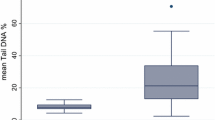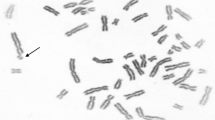Abstract
Diisocyanates are chemically reactive and induce asthma, but data on genotoxic effects of diisocyanates in humans are limited. The investigation presented here used short term diisocyanate chamber exposure to study DNA strand breaks in lymphocytes of 10 healthy individuals and of 42 workers, with airway symptoms, who had previously been exposed to diisocyanates. The alkaline version of the Comet assay was used to analyse DNA strand breaks in lymphocytes. In addition, blood samples of 10 further control individuals without any exposure to diisocyanates were studied. Substances studied were 4,4′-methylenediphenyldiisocyanate (MDI, n=25), 2,4-toluenediisocynate and 2,6-toluenediisocyanate (TDI, n=5), and 1,6-hexamethylenediisocyanate (HDI, n=12), at concentrations between 5 and 30 ppb for 2 h. Lymphocytes isolated from the subjects before exposure and 30 min and 19 h after were used to evaluate DNA damage. No significant changes in DNA strand-break frequencies were measured, as Olive tail moment (OTM), either between groups or before and after diisocyanate exposure. OTM was similar in subjects with an asthmatic reaction (MDI, n=5; TDI, n=1; HDI, n=1) and in subjects without such a reaction. However, a small and susceptible group (about 10% of the individuals studied) could be identified with higher frequencies of DNA strand breaks in lymphocytes after chamber exposure. The occurrence of DNA damage in this group may be based on indirect mechanisms such as oxidative stress or apoptosis.



Similar content being viewed by others

References
American Thoracic Society (ATS) (1995) Standardization of spirometry—1994 update. Am Rev Respir Dis 152:1107–1136
American Thoracic Society (ATS) (2000) Guidelines for methacholine and exercise challenge testing-1999. Am J Respir Crit Care Med 161:309–329
Aynacioglu AS, Nacak M, Filiz A, Ekinci E, Roots I (2004) Protective role of glutathione S-transferase P1 (GSTP1) Val105Val genotype in patients with bronchial asthma. Br J Clin Pharmacol 57:213–217
Barnes PJ (1990) Reactive oxygen species and airway inflammation. Free Radic Biol Med 9:235–243
Bernstein JA (1996) Overview of diisocyanate occupational asthma. Toxicology 111:181–189
Boiteux S (1993) Properties and biological functions of the NTH and FPG proteins of Escherichia coli: two DNA glycosylases that repair oxidative damage in DNA. J Photochem Photobiol B: Biol 19:87–96
Bolognesi C, Baur X, Marczynski B, Norppa H, Sepai O, Sabbioni G (2001) Carcinogenic risk of toluene diisocyanate and 4,4′-methylenediphenyl diisocyanate: epidemiological and experimental evidence. Crit Rev Toxicol 31:737–772
Bowler RP (2004) Oxidative stress in the pathogenesis of asthma. Curr Allergy Asthma Rep 4:116–122
Collins AR, Dusinska M, Gedik CM, Stetina R (1996) Oxidative damage to DNA: do we have a reliable biomarker? Environ Health Perspect 104(Suppl 3):465–469
Collins A, Dusinska M, Franklin M, Somorovska M, Petrovska H, Duthie S, Fillion L, Panayiotidis M, Raslova K, Vaughan N (1997) Comet assay in human biomonitoring studies: reliability, validation, and applications. Environ Mol Mutagen 30:139–146
Czuppon AB, Marczynski B, Scheer E, Hartmann R, Baur X (1993) Increased incidence of anti-dsDNA autoantibody concentrations in sera of workers occupationally exposed to diisocyanates. Toxicol Lett 66:29–34
Dharmarajan V, Weill H (1978) Physical state of airborne p,p′-diphenylmethane diisocyanate (MDI) and its measurements. Am Ind Hyg Assoc J 39:737–744
Emelyanov A, Fedoseev G, Abulimity A, Rudinski K, Fedoulov A, Karabanov A, Barnes PJ (2001) Elevated concentrations of exhaled hydrogen peroxide in asthmatic patients. Chest 120:1136–1139
Fairbairn DW, Olive PL, O’Neill KL (1995) The comet assay: a comprehensive review. Mutat Res 339:37–59
Horvath I, Donnelly LE, Kiss A, Kharitonov SA, Lim S, Fan Chung K, Barnes PJ (1998) Combined use of exhaled hydrogen peroxide and nitric oxide in monitoring asthma. Am J Respir Crit Care Med 158:1042–1046
IARC (International Agency for Research on Cancer) (1986) IARC Monographs on the evaluation of the carcinogenic risk of chemicals to humans, vol 39. Some chemicals used in plastics and elastomers. IARC Press, Lyon, pp 287–323
Lantz RC, Lemus R, Lange RW, Karol MH (2001) Rapid reduction of intracellular glutathione in human bronchial epithelial cells exposed to occupational levels of toluene diisocyanate. Toxicol Sci 60:348–355
Mäki-Paakkanen J, Norppa H (1987) Chromosome aberrations and sister chromatid exchanges induced by toluene diisocyanate and methylenediphenyl diisocyanate in cultured human lymphocytes. Toxicol Lett 36:41–45
Mantell LL, Lee PJ (2000) Signal transduction pathways in hyperoxia-induced lung cell death. Mol Genet Metab 71:359–370
Mapp CE, Fryer AA, De Marzo N, Pozzato V, Padoan M, Boschetto P, Strange RC, Hemmingsen A, Spiteri MA (2002) Glutathione S-transferase GSTP-1 is a susceptibility gene for occupational asthma induced by isocyanates. J Allergy Clin Immunol 109:774–776
Marczynski B, Czuppon AB, Hoffarth HP, Marek W, Baur X (1992a) DNA damage in human white blood cells after inhalative exposure to methylenediphenyl diisocyanate (MDI)-case report. Toxicol Lett 60:131–138
Marczynski B, Czuppon AB, Marek W, Baur X (1992b) Indication of DNA strand breaks in human white blood cells after in vitro exposure to toluene diisocyanate (TDI). Toxicol Ind Health 8:157–169
Marczynski B, Rihs HP, Rossbach B, Hölzer J, Angerer J, Scherenberg M, Hoffmann G, Brüning T, Wilhelm M (2002) Analysis of 8-oxo-7,8-dihydro-2′-deoxyguanosine and DNA strand breaks in white blood cells of occupationally exposed workers: comparison with ambient monitoring, urinary metabolites and enzyme polymorphisms. Carcinogenesis 23:273–281
Marczynski B, Merget R, Teschner B, Korn M, Rabstein S, Brüning T (2003) Changes in low molecular weight DNA fragmentation in white blood cells after diisocyanate exposure of workers. Arch Toxicol 77:470–476
McKelvey-Martin VJ, Green MHL, Schmezer P, Pool-Zobel BL, de Meo MP, Collins A (1993) The single cell gel electrophoresis assay (Comet assay): a European review. Mutat Res 288:47–63
Östling O, Johanson KJ (1984) Microelectrophoretic study of radiation-induced DNA damages in individual mammalian cells. Biochem Biophys Res Commun 123:291–298
Peel M, Marczynski B, Baur X (1997) Comparison of the binding potential of various diisocyanates on DNA in vitro. Toxicol Environ Health 26:517–526
Pitarque M, Vaglenov A, Nosko M, Hirvonen A, Norppa H, Creus A, Marcos R (1999) Evaluation of DNA damage by the Comet assay in shoe workers exposed to toluene and other organic solvents. Mutat Res 441:115–127
Pouget JP, Ravanat J-L, Douki T, Richard M-J, Cadet J (1999) Measurement of DNA base damage in cells exposed to low doses of γ-radiation: comparison between the HPLC-EC and comet assays. Int J Radiat Biol 75:51–58
Rojas E, Lopez MC, Valverde M (1999) Single-cell gel electrophoresis assay: methodology and applications. J Chromatogr 722:225–254
Singh NP, McCoy MT, Tice RR, Schneider EL (1988) A simple technique for quantitation of low levels of DNA damage in individual cells. Exp Cell Res 175:184–191
Vock EH, Hoymann HG, Heinrich U, Lutz WK (1996) 32P-postlabeling of a DNA adducts derived from 4,4′-methylenedianiline, in the olfactory epithelium of rats exposed by inhalation to 4,4′-methylenediphenyl diisocyanate. Carcinogenesis 17:1069–1073
Vock EH, Vamvakas S, Gahlman R, Lutz WK (1998) Investigation of the induction of DNA double-strand breaks by methylenediphenyl-4,4′-diisocyanate in cultured human lung epithelial cells. Toxicol Sci 46:83–89
Weiss ST (1996) Issues in phenotype assessment. In: Liggett SB, Meyers DA (eds) The genetics of asthma. Marcel Dekker, New York, pp 401–419
Wikman H, Piirila P, Rosenberg C, Luukkonen R, Kaaria K, Nordman H, Norppa H, Vainio H, Hirvonen A (2002) N-Acetyltransferase genotypes as modifiers of diisocyanate exposure-associated asthma risk. Pharmacogenetics 12:227–233
Acknowledgements
We thank A. Düker, B. Engelhardt, and E. Schomberg for technical assistance.
Author information
Authors and Affiliations
Corresponding author
Rights and permissions
About this article
Cite this article
Marczynski, B., Merget, R., Mensing, T. et al. DNA strand breaks in the lymphocytes of workers exposed to diisocyanates: indications of individual differences in susceptibility after low-dose and short-term exposure. Arch Toxicol 79, 355–362 (2005). https://doi.org/10.1007/s00204-004-0639-z
Received:
Accepted:
Published:
Issue Date:
DOI: https://doi.org/10.1007/s00204-004-0639-z



